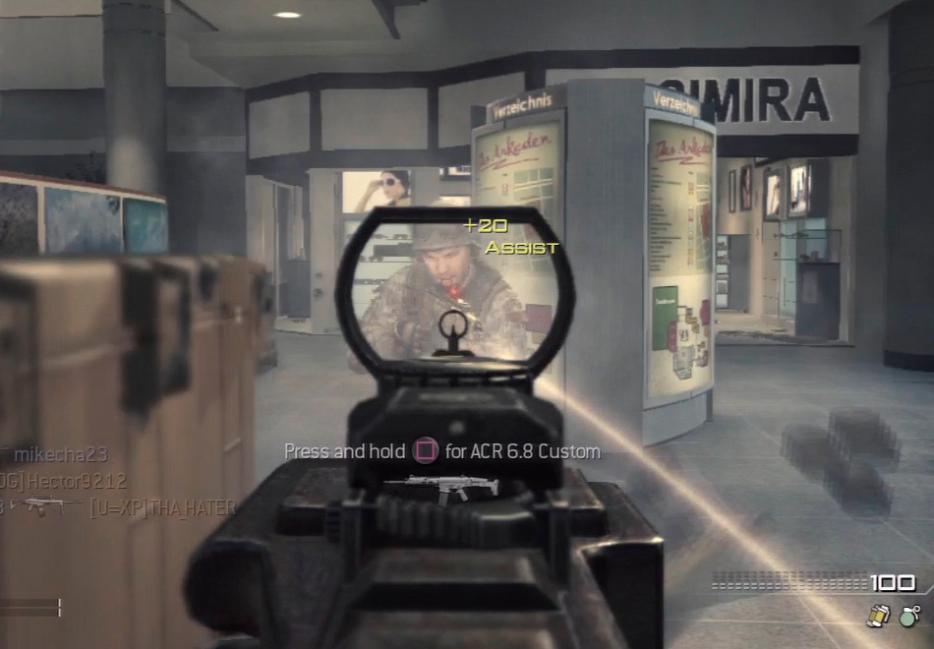After the Parkland shooting, President Trump blamed the murders on violent video games. In practice, this meant hastily setting up a summit with executives from video game companies, members of congress, and representatives from conservative think tanks at which the president played an 88-second supercut of violence in video games including Fallout, Wolfenstein, Sniper Elite 4, and multiple titles from the Call of Duty franchise. After the video played, Trump reportedly turned to the assembled parties and said, “This is violent, isn’t it?” There were few, if any, actual policy options on the table, and it seems unlikely that the video game industry will take any of Trump’s suggestions. Which is to say, it was yet another installment in a long history of empty political controversy over games, and the latest iteration of an endlessly replicable and largely meaningless discourse.
In the era of mass shootings that has followed since Columbine, a recognizable pattern has emerged. Activists call for gun control measures while politicians respond that, actually, the shooting happened because of cultural decay exemplified by the shooter’s love of violent video games, or movies, or TV shows. (In the case of Columbine, a debunked rumor claimed that Eric Harris created custom high school levels for the game Doom.) Then, news outlets and “experts” push back, using social science research to “prove” that there is, in fact, no connection between violent games and gun violence. This has become the standard talking point in response to the argument against violence in culture: to completely deny the possibility that it might contribute to the strain of the national subconscious that perpetually asserts itself in blood. There are many, many other factors that contribute to the frequency of mass shootings—access to firearms chief among them—but they exist within a broader ecosystem of contributing factors, rather than on top of or before them.
People will tie themselves into ideological knots defending their stances on this cultural issue; even The Los Angeles Times published an op-ed arguing—to what audience?—that Antonin Scalia, of all people, would oppose the link between violent games and violent actions. (To be fair, American courts have repeatedly protected the existence of violent media as a form of expression: the Columbine victims’ families’ lawsuit against entertainment companies was dismissed by a judge.) And while Columbine occurred at a particular moment during the rise of now-omnipresent shooter games, it happened a few years after Joe Lieberman’s Mortal Kombat hearings, which led to the creation of the ESRB rating system.
America’s mass shooting epoch is new, but the specific arguments about the role of video games in generating real violence are an escalation of old, cyclical debates over the influence of culture on consumers. Writing in The Atlantic in 2013, Alexander Abad-Santos took this systemic view by articulating shooters’ obsessions with games as a “symptom” of deeper issues. Among those issues: depression, which Abad-Santos suggests may be comorbidly linked to playing video games—they exist in a vicious cycle. One could think of any number of other psychological or moral issues that might exist in a similar relation.
Abad-Santos describes these arguments as a “race to pin the blame,” which certainly captures the feeling of watching conservatives shout about games in the wake of a shooting. Frequently, pushback against calls for censorship (correctly) describe these crusaders as using video games as a scapegoat, putting up a smokescreen for a gun lobby happy to blame America’s mass shooting hobby on anything besides easy access to guns. (In 2012, the NRA’s Wayne LaPierre literally described video game companies as “a callous, corrupt and corrupting shadow industry that sells, and sows violence against its own people.”) But defenders put an enormous amount of time and energy into disproving any possible link between violent video games and violent actions. This effort is not only impossible, it has the effect of obscuring a much bigger issue and admittedly more difficult set of questions: Not whether culture can influence people at all, but how it does, and how we should respond to it.
Because of course it can—that’s the whole point of culture. If you’ve been moved by the sadness of Call Me By Your Name, repeated a joke from a book, or used the phrase “Sam and Diane” to illustrate and simplify the complexities of a real-life romantic entanglement, culture has acted upon you in some way. Even the commonly cited social science research suggests that there is a more pervasive, complex way of understanding the influence culture has on people than simply saying a movie or game can cause someone to act in a certain way. Writing for The Guardian, Katherine Cross summarizes: “What has been clear to social scientists for a long time is that the ‘monkey-see-monkey-do’ model of media influence is a fiction. They may influence passive behaviours such as stereotyping, but they absolutely do not cause active, violently antisocial behaviour like murder.”
People who instinctively deny the capacity for violent entertainment to contribute to violent actions—broadly speaking, the type of liberal who earnestly tries to respond to obviously disingenuous criticism with a set of numbers—are quick to recognize culture’s capacity to influence people in many other cases. The president’s brain has been rotted by cable news, and his election was in part the culmination of reality television and the twenty-four-hour news industry’s influence on American culture. (True.) Representation of marginalized people is valuable. (Also true.) It’s cool to wear things because Rihanna wore them. (Absolutely, one hundred percent true.) There are even cases where many people who otherwise resist any attempt to link culture and violent behavior are willing to admit that art might negatively affect people who watch it, as in cases of reasonable public outcry against works like Zero Dark Thirty or American Sniper, which glorify not just violence, but the use of violence by the American military. One other example, that demands some regulation: depictions of smoking, which the MPAA seemingly does take into consideration—at least, sometimes.
Why, then, is it so difficult to admit that there might be something wrong with not just the amount of violence we’re exposed to, but also the way we’re exposed to it? Admitting the very possibility does not, of necessity, enjoin us to the conservative conclusion that video games are “really” the problem instead of guns, or inequality, or racism, or untreated mental illness, or any of the thousand institutional and systemic factors that produce alienation and pain. In an interview with The Outline, academic Alfie Bown puts it succinctly: “games like GTA create the appearance that there is a desire to do such things, whether we do them or not.” This is true of all culture, which stretches the imaginative bounds of what human life can and should be, even if that stretching does not happen in an especially “serious” direction. The existence of Grand Theft Auto gives us the potential to imagine an infinite, consequence-free crime spree. The existence of Fate of the Furious gives us the potential to imagine a chase between Vin Diesel, Dwayne “The Rock” Johnson, and a submarine piloted by Charlize Theron.
Our decades of argument about violent video games, movies, and television shows has produced a full archive of denial, but it’s just one part of a broader conversation about culture and art’s potential to influence consumers, a topic that dates all the way back to Plato, whose work repeatedly cast aspersions on playwrights, musicians, and artists because their work could potentially corrupt the youth. (It’s easy to be dismissive of Plato’s concern with censorship, but he had at least some skin in the game—one of the crimes Socrates was charged with, and eventually convicted of, was corrupting the youth of Athens with his words.)
Culture, like most human actions and interactions, exists as a constant, chaotic series of feedback loops. Symbols—Batman, Master Chief, Carly Rae Jepsen—acquire meaning and force in part because they have been invested with it by people who then transmit it to others. The simple fact of acknowledging this power, again, does not require us to take any course of action other than continuing to be honest about our tastes, our judgments, and our sense of ethics. We protest or otherwise disparage politically objectionable works like Eli Roth’s airless, gleefully cruel Death Wish remake because they do have power—even if that power merely lies in making the unimaginably horrific seem bland and boring. And, of course, part of the influence of these works is a result of communicating the sensibilities of their makers—people who, as we are becoming ever-more aware, are frequently monstrous.
Blaming eruptions of tangible, physical violence solely on culture is obviously misguided at best and disingenuous at worst. If pressed, I suspect most people would agree that there is at least some cultural influence at work here—but I doubt they would be willing to say what, exactly, it was. For years, I found myself instinctively, reactively arguing in any and all situations that there was no reason to even have the discussion. And therein lies the problem. We may all be willing to admit that culture has some influence on people, and that that influence might not be especially salutary. But it’s rare for people to earnestly, enthusiastically, and honestly take the next step—identifying what culture has a bad influence, how that influence exerts itself, and how to avoid it—because that seems like playing on the turf of the zealots. Learning to speak this language, developing our taste and sensibilities and, yes, our moral awareness, until we can confidently say that something is bad for the soul, is of the utmost importance.
This is not an easy task. It requires a clear-sightedness that can be unpleasant at best and downright incriminating at worst. All of us love culture that is not strictly good for us—it’s part of being an embodied, frail, chemical-fueled human. Whether it’s The Walking Dead, The Real Housewives, or the collected works of Woody Allen, the task before people who care about culture is not to expunge anything we think might be bad for us. Doing so would be impossible, and even thinking of it as an option is part of a creep toward reactionary haze. The goal is to say why those things are bad, and if we continue to consume them anyway, then to at least admit that that is what we are doing. (Consuming mass media is, essentially, one big ethical cheat day.) The task before us, then, is to do honest and thoughtful criticism.
To start, this means being willing to agree that even meaningful, important art can potentially have an unpleasant effect on the soul, and that consuming such art (and even liking it) doesn’t make you or anyone else, of necessity, a bad person. It means acknowledging not just the text of a work by itself, but also the conditions under which it is consumed, and the people doing the consumption. Grand Theft Auto, played in isolation by someone already inclined to antisocial behavior, is more likely to contribute to an outburst of violence than Grand Theft Auto played by fans of open world games who just like driving around listening to the radio stations. And an obsessive player in Sweden will take away different things than an American, though they are both interacting with the same coded scenario—it’s hard to make these sorts of moral judgments, and doing so effectively requires being attentive to all of the different contexts that weave together into a single experience. And it means centering our work on how a work of art represents and asks us to engage with something, rather than simply on what is being depicted.
It would be impossible to account for all of these factors in a single sweeping piece of criticism, but that’s the point. The top-level debate about “violent video games” says nothing about this violent video game, whether that game is Doom, Halo, or Assassin’s Creed. There are absolutely games with more superficial gore that manage to present their subject matter in complex, ethically thoughtful ways—or, at least, more directly politically argumentative ones—and heavily pixelated, relatively bland ones that are far more insidious. (NRA: Practice Range was unceremoniously removed from the app store.) Talking about senseless murder in action movies doesn’t mean anything until it becomes a conversation about specific works.
Nikolas Cruz, the Parkland shooter, reportedly played video games for up to fifteen hours a day. Does the president know what games? And if Trump did know what games Cruz played, would he or anyone else engaged in our public conversation about mass shootings have the cognitive tools to effectively consider how those games influence and shape players? If we are committed to honesty, and to not being wrong-footed by bad-faith ideologues, we have to be willing to take up those questions ourselves, and to say that, for example, the Call of Duty series may consist of mostly cookie-cutter, interchangeable games that flatten violence—but that this doesn’t mean it’s capable of getting single-handed grip on someone’s mind.
Instead, it means that artists in all fields have an obligation to grapple more seriously with how they depict violence rather than avoiding the question, and to do so in a setting free from interlocutors like the president. “This is violent, isn’t it?” isn’t an open question, really. (It is.) But part of the answer to the bigger question—if we’ll ever stop finding ourselves in this situation of not being able to effectively talk about mass death—rests on whether we can start to do the work of asking how, and why.






